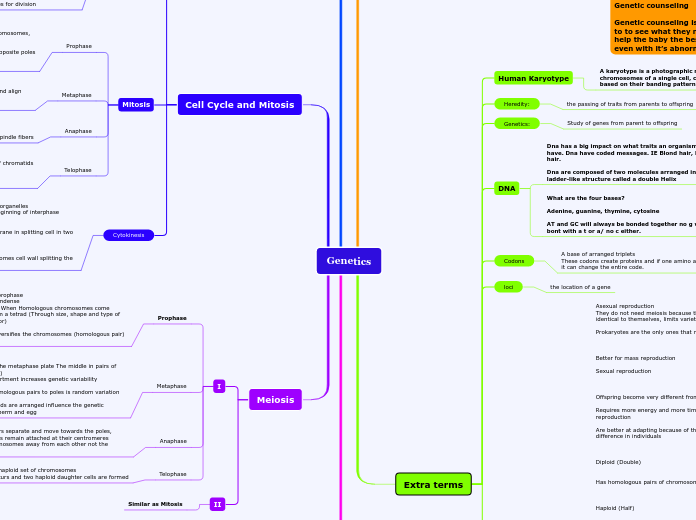
Haplodiploid system
When an individual cannot have a father because there birth is either due to being born without fertilization or with fertilization
Pedigrees
Diagram that shows genetic relationship of the family
Genetic testing
The purpose of genetic testing is to see (in advance) the karyotype of the baby in the amniotic fluid to see if their are an chromosomal abnormalities
Prenatal testing
To see if there are any issues with the baby and what they should consider if these facts and information becomes true.
CVS
Chorionic Villus sampling
Used to see if their are any abnormalities in the baby by looking at the plantera cells, the cells that will make up the fetus
NTS/
Nuchal translucency screening
used to see the anatomy of the baby the heart beat of the baby and the liquid behind the neck of the baby to see if any abnormalities are present
Genetic counseling
Genetic counseling is what some parents go to to see what they need to do in order to help the baby the best way that they can even with it’s abnormalities
Human Karyotype
A karyotype is a photographic representation of the chromosomes of a single cell, cut and arranged in pairs based on their banding pattern and size
Heredity:
the passing of traits from parents to offspring
Genetics:
Study of genes from parent to offspring
DNA
Dna has a big impact on what traits an organism may have. Dna have coded messages. IE Blond hair, black hair.
Dna are composed of two molecules arranged in a ladder-like structure called a double Helix
What are the four bases?
Adenine, guanine, thymine, cytosine
AT and GC will always be bonded together no g will bont with a t or a/ no c either.
Codons
A base of arranged triplets
These codons create proteins and if one amino acid is different it can change the entire code.
loci
the location of a gene
Reproduction Terms
Asexual reproduction
They do not need meiosis because they give rise to offspring identical to themselves, limits variety
Prokaryotes are the only ones that reproduce asexualy
Better for mass reproduction
Sexual reproduction
Offspring become very different from the parent
Requires more energy and more time than asexual reproduction
Are better at adapting because of their variety due to the difference in individuals
Diploid (Double)
Has homologous pairs of chromosomes. Humans have 2n 46
Haploid (Half)
Organism or cell has only one set of chromosomes N, 23
Somatic Cells
All body cells of an organisms
Bone, skin
Reproductive cells
Only found in reproductive areas
Gametes
Male in testes
Female in ovaries
SPERMATOGENESIS:
1 spermatogonium (the parent cell) contains 78 chromosomes and will undergo meiosis to produce 4 haploid sperm cells. These 4 sperm cells each contain half the amount of original chromosomes (i.e. 39 chromosomes).
Oogenesis
the production of ovaries in women body
Four cells get genetics and dna but
One haploid stationary the other 3 are non viable polar bodies
Fertilization
Ovum is released, sperm and ovum can meet
Results in the formation of the zygote
23 M + 23 F meets to form a zygote (2n)
Example of literary work
Agatha Christie - And Then There Were None
Literary Work
Example of real world
A divorcing couple
Conflict of real world
Interphase
Super long strand of chromatin
Chromosome of one chromatid duplicates to make another clone.
They become sister chromatids
G1 phase= growth
S phase = DNA synthesis
G2= Cell functions, growth,prepares for division
Mitosis
Prophase
Pair
Chromatid condensed to form chromosomes,
Nuclear membrane breaks down
Duplicated centrioles migrate to opposite poles
Spindle fibers begin to form
Metaphase
Middle
Spindle fibers attach to chromosomes centromere and align along equatorial plate
Each sister chromatid faces opposite poles
Anaphase
Apart
Centromere splits
Sister chromatids are pulled to opposite poles by spindle fibers
Telophase
Two
Nuclear membrane forms around each set of chromatids
Spindle fibers disappear
Chromatids decondense into chromatin
Cytokinesis
Final division of the cytoplasm and organelles
Occurs at the end of mitosis and beginning of interphase
Animal cells
Cleavage furrow pinches cell membrane in splitting cell in two
Plant cell
Cell plate forms and eventually becomes cell wall splitting the cells into two
I
Prophase
90% is spent in prophase
Chromosomes condense
Synapsis occurs: When Homologous chromosomes come together and form a tetrad (Through size, shape and type of gene they code for)
Crossing over Diversifies the chromosomes (homologous pair) “Chiasmata”
Metaphase
Shortest phase
Tetrads align on the metaphase plate The middle in pairs of two 12(horizontal)
independent assortment increases genetic variability
Orientation of homologous pairs to poles is random variation
The way the tetrads are arranged influence the genetic variation in the sperm and egg
Anaphase
Homologous pairs separate and move towards the poles,
Sister chromatids remain attached at their centromeres
Pulling the chromosomes away from each other not the chromatids
Telophase
Each pole has haploid set of chromosomes
Cytokinesis occurs and two haploid daughter cells are formed
II
Similar as Mitosis
Chromosomal Abnormalties
If you have an extra copy of chromosomes 3 instead of one then you’ll be diagnosed with trisomy 21 -down syndrome
Older parents are more likely to have chromosomal abnormalities
It can go from 100% to chromosomal abnormalities to 50% just by when the nondisjunction occurs
Chromosomes structure
Duplication
Specific code gets duplicated
Deletion
A portion of the code gets deleted
Inversion
A portion of the code gets inverted
Translocation
An entire segment of code is shifter into the wrong location